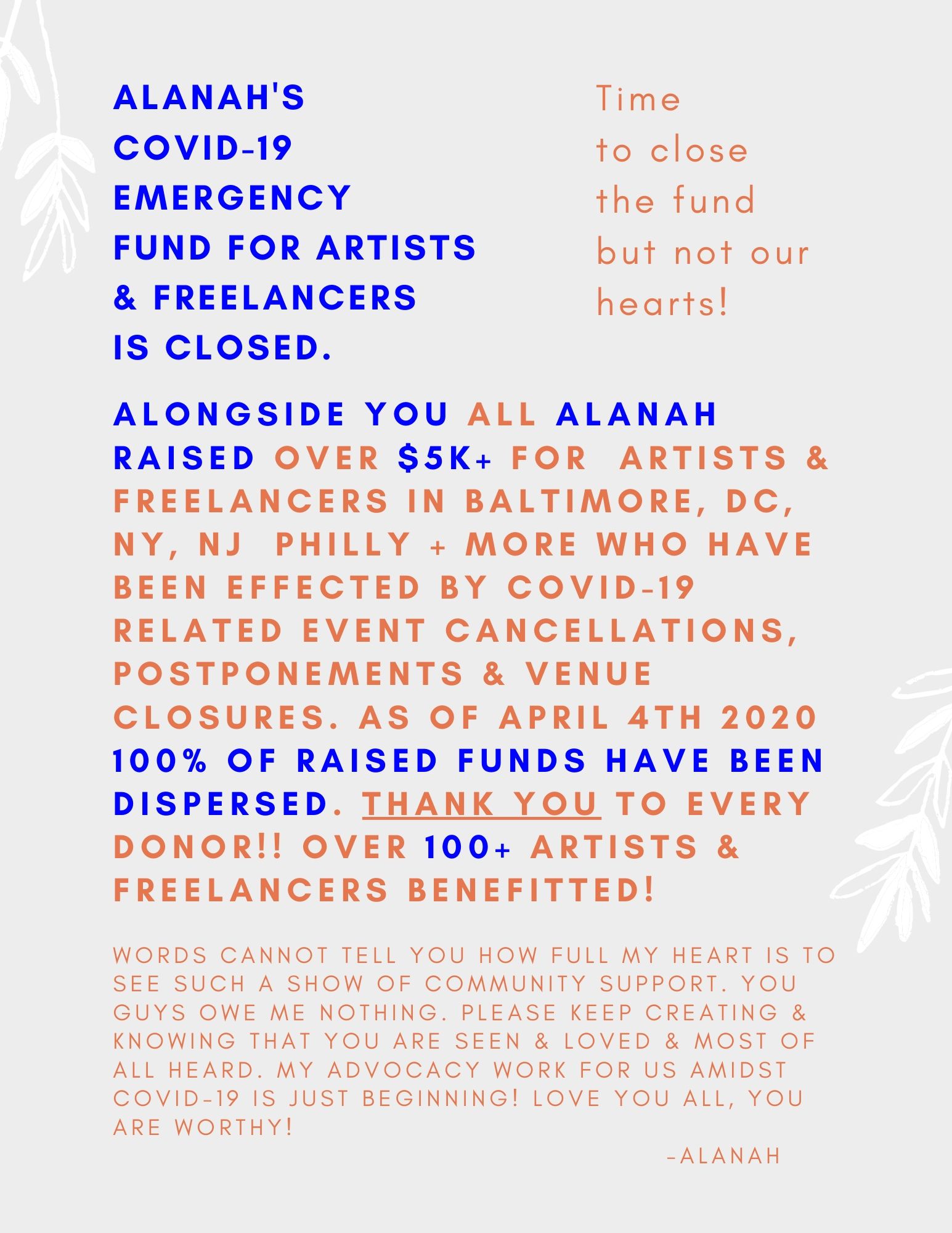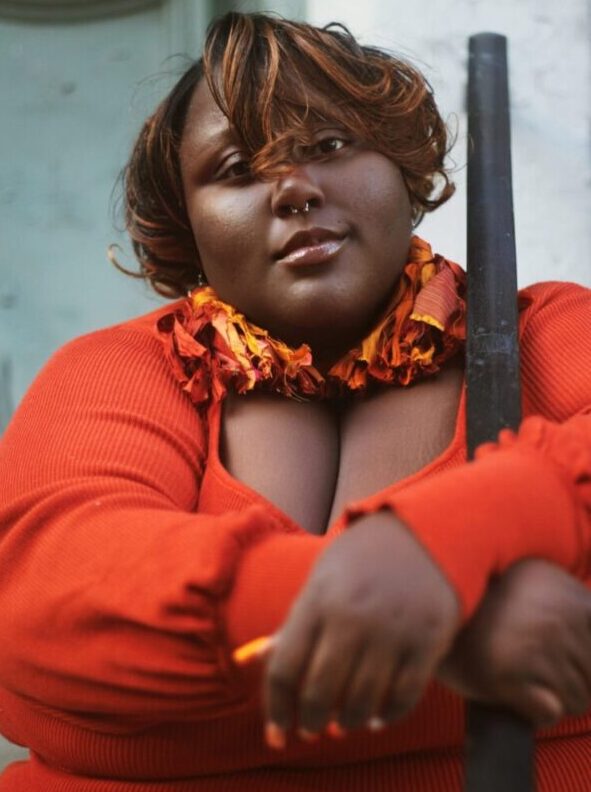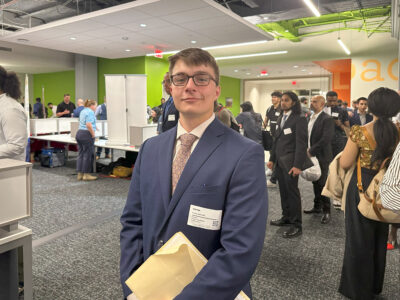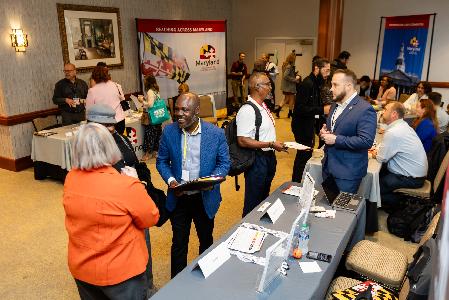Since 2008, I’ve been involved in the creative community in Baltimore — first as an observer, then as a patron and now an avid participant of the arts.
As an established cultural worker at the intersections of blackness, motherhood, queerness and entrepreneurship, I’ve felt the impact of COVID-19. Along with others, the creative and gig economy around the world has crashed amid the global pandemic. Creatives in Baltimore have been dramatically affected by vast COVID-19 related cancellations and postponements. That means food, medical costs and supplies are at the forefront of support needs for our creative community.
Organizational structures like mutual aid, where communities can voluntarily seek a reciprocal exchange of resources for a mutual benefit, became of interest to me in early March 2020. I was looking to show my peers and extended creative community a bit of humanity and rapid response. I deemed myself poised for the task after reflections on how much trust I had built and my propensity for producing outcomes in the arts. Over the years I’ve served my community enough to know that my concerns for the creative economy would be shared.
On the morning of March 13, 2020 I jotted a small social equation down into my MAC notes: Community Trust + Common Concern x Humanity = Outcomes.
By that afternoon I had a Google form for Alanah’s COVID-19 Emergency Fund for Artists and Freelancers. These principles would usher me into a new role in the arts, philanthropist, and grantmaker.
Let’s break down the equation:
Community Trust +
With my self-imposed title of arts philanthropist and grantmaker, it was and is my job to see that my immediate creative community included hundreds of artists and freelancers across mediums and identities with whom I’ve built trust through public in-person events. Collectively, the community lost copious amounts of revenue as a result of vast cancellations and postponements.
Using Canva to design various infographics, I announced my funds’ application and clearly outlined ways to give socially and monetarily daily. By uploading personalized video updates for supporters, I helped web passersby to stay abreast. To collect donations, I used my payment services like Cashapp, PayPal and Venmo.
https://www.instagram.com/tv/B99cT6jpbDL/
Transparency was key while organizing my fund, since I opted out of using crowdfunding apps like GoFundMe. I was fortunate enough to gain earned media mentions about the work I was doing, which affirmed the validity of the opportunity for funds and spread the word further than I could’ve ever done alone. The concern for artists and freelancers losing revenue due to COVID-19 was and still is common.
Common Concern x
I’ve served my community in many different capacities over the years outside of the arts. At 19, in my role as a cashier at Royal Farms, I learned the importance of fast response.
At the age of 23 as an Emergency Room Nurse Technician (Certified Nursing Assistant), I learned to triage emergencies quickly by listening to patients. I’d do rounds on my patients before two hours would pass. I’d have conversations with them. I knew their names, maybe where they were from and especially how much pain they were in, if any. Early in your healthcare career, you watch the capacity of experienced registered nurses and hope to someday be like them. (A huge warm thank you to RN’s and Hospital Staff for their service). You hope to one day build enough knowledge to triage and get the diagnosis right and quick.
Good philanthropy and grantmaking starts from listening to the humans you want to best serve.
Currently, at 28, my role in the creative community parallels that healthcare experience in a lot of ways. Collective care is not just about the money. It’s about the triage, doing your rounds on the community and diagnosing ailments quickly. Knowing someone is there for them during a crisis is purely physiological, purely human. Good philanthropy and grantmaking starts from listening to the humans you want to best serve.
Humanity =
In arts and culture in many cities, the anchor institutions, foundations and funders that creative communities rely heavily on don’t do those aforementioned rounds enough. After conversations with over 100 artists and freelancers, I found that, across the U.S., artists were experiencing their first touchpoints with grants or formalized applications for relief — in some cases after 15 years in relationship to the arts.
It’s my opinion that our first time hearing from these arts institutions, foundations and funders, shouldn’t be when something goes extraordinarily wrong. They have to learn to do their rounds.
The creation of technical assistance for artists in and out of the COVID-19 crisis is imperative. As creatives, we look to these institutions as a young nurse technician would look to an RN: They are far more heavily resourced and experienced. As a creative community we have to model social solidarity even amid physical distancing in the hopes that large organizations will see the crisis, pre-triaged, and mirror that care we show for each other —as an experienced RN would for his or her patient. It’s in this type of care and dignity that we find outcomes.
Outcomes.
Having gone forward both informed and empowered by the community I wished to serve, I organized a successful mutual aid fund. Alongside over 90 donors ranging from individuals to foundations, I closed out my fund in April after raising over $5,000. I dispersed 100% of the funds to exactly 100 artists and freelancers in need who applied through a Google form in my Instagram Bio.
The folks who received the microgrants, ranging from $25-$100, are artists and freelancers in my immediate creative community of Baltimore and extended communities in New Jersey, New York, Philly, California and Arizona. I kept 0% of those funds for myself and used small percentages to cover transfer fees for my mobile payment apps.
Was I “solving” the problem completely? No. But was I contributing to a boost in morale when my peers were scared and unsure about the future of their revenue due to COVID-19? Yes.
I implore readers to consider organizing a fund or donating to funds like Alanah’s COVID-19 Emergency Fund for Artists and Freelancers. In the creation of the fund even a tad of a butterfly effect started to ensue: Folks who had received funds gave back to the fund once stimulus checks cleared or unemployment came in. Collective care is contagious.
Social solidarity is a building block that my usually very in-person world thrives on. We may be online, practicing safe social distancing but we are still together.

A graphic created for Alanah’s COVID-19 Emergency Funds for Artists and Freelancers. (Courtesy photo)
So what have I been up to since?
I’m a mother of two girls, Blair (8) and Harper (6), for whom I’m supporting distance learning. I blend my personal and professional responsibilities while working from home, as I’ve been tuned into various Zoom calls, partnerships, juries, task forces and independent conversations with the Maryland State Arts Council, Baltimore Office of Promotion and The Arts, Baltimore Creatives Acceleration Network, National Black Arts Festival and more. Check out the full schedule of upcoming related conversations at my website. I’m still under contract with several local and global nonprofits as a marketing consultant. I’ve found time to apply and get awarded relief fund grants from places like The Soze Foundation, Warnock Foundation, Art on The Vine, TILA Studios and Breakout Foundation, to name a few. I love to write and have contributed other writings to Technical.ly. To decompress, I visit Druid Hill Park and commission artists all over the globe to draw portraits of me to continue to infuse the creative community.

This guest post is a part of Technical.ly's Community Building Month of our editorial calendar.
Before you go...
Please consider supporting Technical.ly to keep our independent journalism strong. Unlike most business-focused media outlets, we don’t have a paywall. Instead, we count on your personal and organizational support.
Join our growing Slack community
Join 5,000 tech professionals and entrepreneurs in our community Slack today!





